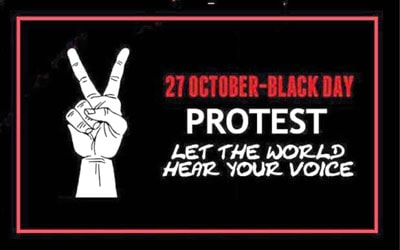Muhammad Raza Malik
October 27 is the darkest day in the history of Jammu and Kashmir. Kashmiris on both sides of the Line of Control and the world over observe it as a Black Day because on this day in 1947 India had forcibly occupied Jammu and Kashmir by landing its army in Srinagar against the will of the Kashmiri people and in total disregard to the Indian Inde-pendence Act and Partition Plan.
Under the Indian Independence Act and Parti-tion Plan of 1947, the Indian British Colony was divided into two sovereign states, India – with Hindu-majority areas – and Pakistan – with the Muslim-majority areas of Western provinces and East Bengal.
As per the understanding behind the Partition Plan, the then Princely States were free to accede either to Pakistan or India on the basis of their geography and demography.
Muslim Majority Jammu and Kashmir was a natural part of Pakistan as both shared strong bonds in respect of religion, geography and culture.
But, unfortunately, the then Hindu ruler of Jammu and Kashmir, Maharaja Hari Singh, destroyed the future of Kashmiri people by announcing its accession to India under a controver-sial document, Instrument of Accession, thus laying the foundation of the Kashmir dispute.
Many ob-servers including prominent British historian, Alastair Lamb, and noted Kashmiri researchers, Abdul Majid Zargar and Basharat Hussain Qazil-bash, deny the existence of such a document with the argument that had it been there, the Indian gov-ernment must have made it public either officially or at any international forum.
Even Indian Archives Department’s announcement that the document is lost has put question marks on its very existence.
Indian troops, the forces of Dogra Maharaja, and Hindu extremists massacred over three hundred thousand Kashmiri Muslims in Jammu region while they were migrating to Pakistan within a period of two months with the intention to change the demo-graphic composition of the territory.
Kashmiris’
resistance and mass uprisings
The people of Kashmir rejected India’s illegal occupation right from the day one and through an exemplary struggle succeeded in liberating a vast area now known as Azad Jammu and Kashmir.
Their resilience forced India to approach the United Nations in January 1948, seeking its help in settling the Kashmir dispute.
The UN Security Council adopted successive resolutions that nullified the Indian occupation and called for resolving the dis-pute through holding of plebiscite in Jammu and Kashmir.
After the failure of all peaceful means to settle the Kashmir dispute, the Kashmiris intensified their struggle in 1989 to get rid of Indian illegal occupa-tion.
The people of IIOJK added a new dimension to their freedom movement in 2008. They hit the streets in thousands during mass uprisings in 2008, 2009, 2010 and 2016.
At times, over one million people were seen marching on the streets of Srina-gar, demanding their right to self-determination.
Unfortunately, instead of taking these massive pro-tests as Kashmiris’ referendum against its illegal occupation, India responded by subjecting the peaceful protesters to brute force including firing of bullets, pellets and teargas shells, killing hundreds of them and injuring thousands others.
Indian state
terrorism
New Delhi has exhausted all its resources and used every brutal tactic during the past over seven decades but has miserably failed to intimidate the people of occupied Jammu and Kashmir into sub-mission and efface their love for Pakistan from their hearts.
Since 1989, when the people of occupied Kashmir intensified their freedom struggle, till 24 October 2021, Indian troops have martyred 95,894 innocent Kashmiris, widowed 22,934 women, or-phaned 107,842 children and molested or gang-raped 11,246 Kashmiri women.
While the where-abouts of thousands of innocent youth subjected to disappearance in custody remain untraced, the dis-covery of thousands of mass graves across the terri-tory has raised concerns about their safety.
Since the mass uprising triggered by the extrajudicial killing of popular youth leader, Burhan Wani, on 8th July in 2016, besides killing over 1,480 Kashmiris, the troops have caused injuries to more than 29,840 people by firing pellets, bullets and teargas shells on protesters.
During this period, more than 11,400 people have suffered pellet injuries. Of these pellet victims, 2,000 have been hit in the eyes and around 200 of them have lost their eyesight in one or both eyes.
However, all these Indian brutalities have failed to subdue the Kashmiris’ freedom sentiment and they are determined to take their struggle for securing their inalienable right to self-determination to its logical conclusion at all costs.










